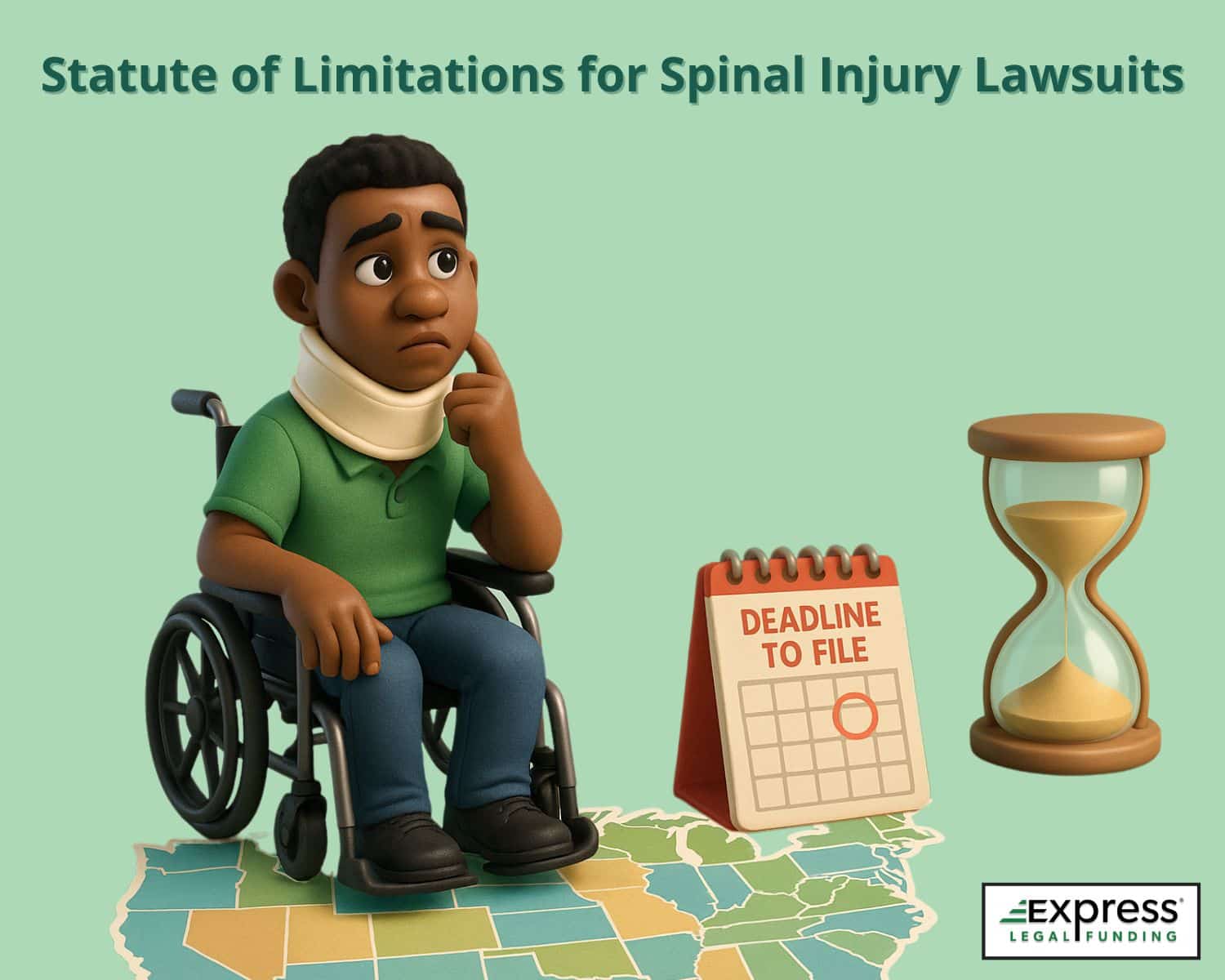
Spinal injuries can result from a wide range of incidents, including car accidents, slips and falls, workplace hazards, and sports-related impacts. While some types of spinal injuries cause immediate and obvious harm, others develop slowly, leading to serious long-term effects like chronic pain, limited mobility, and permanent nerve damage.
These injuries often require ongoing medical treatment, physical rehabilitation, and long-term lifestyle adjustments that place a significant financial and emotional burden on victims and their families.
Whether your spinal injury affects the cervical, thoracic, lumbar, or sacral spine, the symptoms can be complex, and in many cases, delayed spinal symptoms may not appear until weeks or even months after the incident. This makes it all the more important to understand your legal rights early and take timely action.
Why You Must Act Quickly: The Statute of Limitations for Spinal Injury Lawsuits Could Block Your Right to Sue
In many cases, filing a spinal injury lawsuit may be the only way to secure compensation for medical expenses, lost income, and other damages. However, this opportunity is time-sensitive. Statutes of limitations strictly limit how long you have to file a spinal injury claim, and missing your deadline could permanently forfeit your right to compensation.
This expert guide provides a clear, in-depth overview of the legal time limits for spinal injury claims across the United States. Whether your injury was caused by negligence, malpractice, or government employee fault, understanding these deadlines can help you take the right legal steps and protect your future.
Statute of Limitations for Spinal Injury Claims: Overview
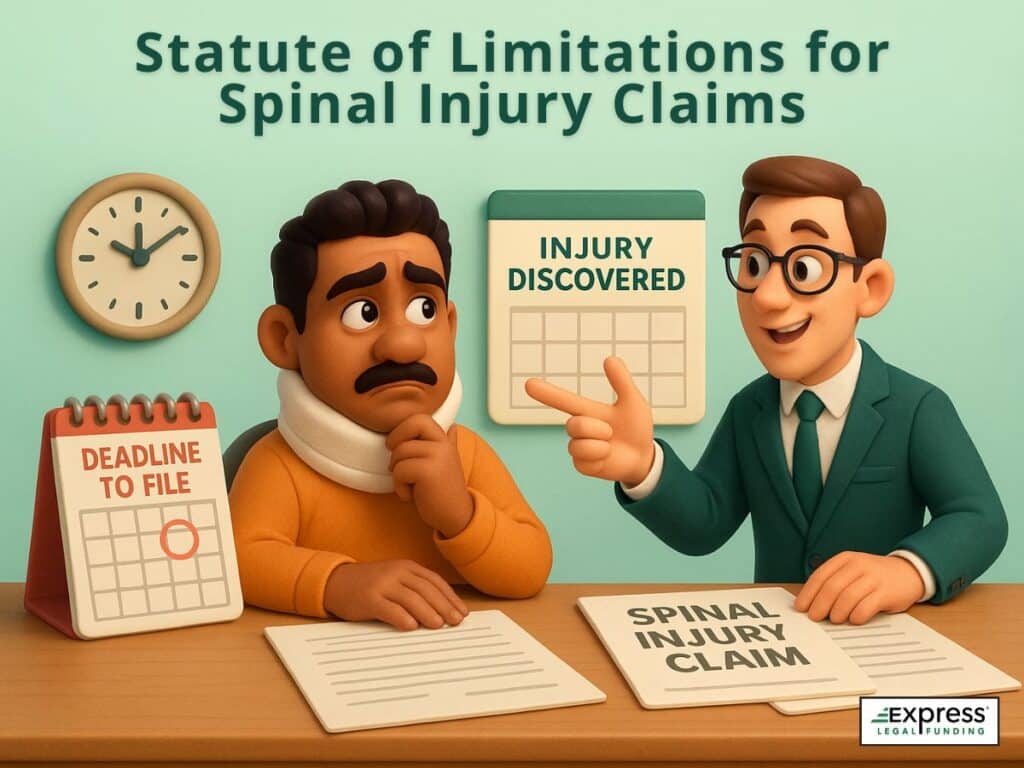
While spinal injuries can lead to lifelong consequences, the window of time to take legal action is not unlimited. This legal deadline is known as the statute of limitations, a rule that sets how long a person has to file a lawsuit after sustaining a spinal injury.
In most cases, the statute of limitations starts on the date of the injury. However, the full extent of spinal damage is not always immediately apparent. Symptoms like nerve pain, mobility loss, or complications from surgery may develop gradually, which complicates matters for victims trying to protect their rights.
Why Courts Enforce Filing Deadlines Strictly
Despite these challenges, the law generally favors prompt legal action. Statutes of limitations exist to:
- Ensure evidence remains fresh
- Maintain the availability of witnesses
- Protect defendants from indefinite legal uncertainty
This creates a difficult reality for spinal injury victims: even if your symptoms worsen over time, waiting too long could cost you the right to seek compensation.
Key Factors That Affect Your Spinal Injury Claim Filing Deadline
It’s also important to understand that the statute of limitations is not the same in every case. The actual deadline to file a spinal injury lawsuit depends on:
- Your state’s laws
- The type of injury claim (e.g., personal injury vs. medical malpractice)
- Who the defendant is (private person vs. government agency)
- Any applicable exceptions, such as the discovery rule or tolling provisions
Each of these variables can significantly affect how much time you really have—and whether a lawsuit is still possible.
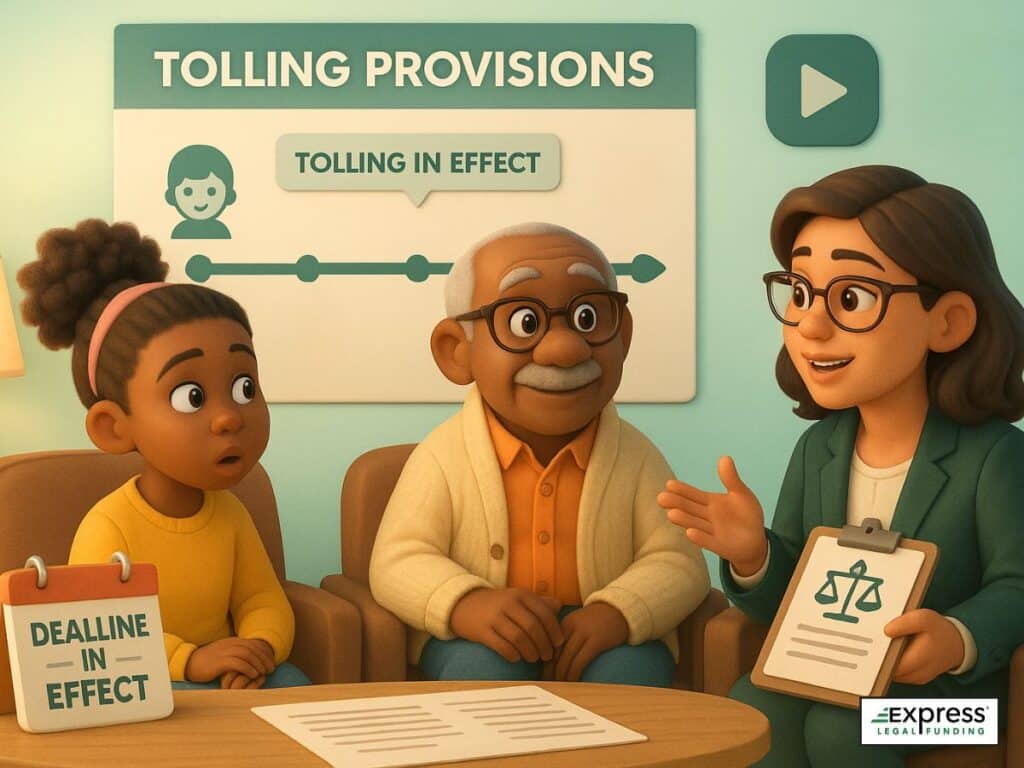
Talk to a Lawyer to Protect Your Right to Sue for Compensation
Because the rules can vary widely by state, claim type, and the parties involved, it’s essential to consult with a qualified personal injury attorney as soon as possible. An attorney can evaluate your case, determine the applicable deadlines, and ensure that your rights are protected before time runs out.
What Is the Average Statute of Limitations for a Spinal Cord Injury Lawsuit?
Most states have a 2 to 3-year filing deadline for spinal cord injury claims. However, this window can vary based on state law, the type of claim (e.g., personal injury vs. medical malpractice), and whether exceptions like tolling provisions or the discovery rule apply.
Exceptions to the Statute of Limitations for Spinal Injury Lawsuits
1. The Discovery Rule: When the Clock Starts Later

In many states, the “clock” doesn’t start until the injury is discovered, or reasonably should have been discovered. This is critical in spinal cases involving slow-developing nerve damage or post-operative complications.
This provision is particularly crucial in cases involving spinal injuries, where symptoms such as nerve damage or post-operative complications may develop gradually and are not immediately apparent.
The discovery rule acknowledges the complex nature of these injuries, providing victims with a fair opportunity to seek legal recourse once they become aware of the harm.
This approach ensures that individuals are not unjustly barred from pursuing compensation due to the delayed manifestation of their injuries. However, the application of the discovery rule can vary by jurisdiction, and proving the date of discovery often requires thorough documentation and expert testimony.
2. Tolling Provisions: Legal Pauses That Extend Your Deadline
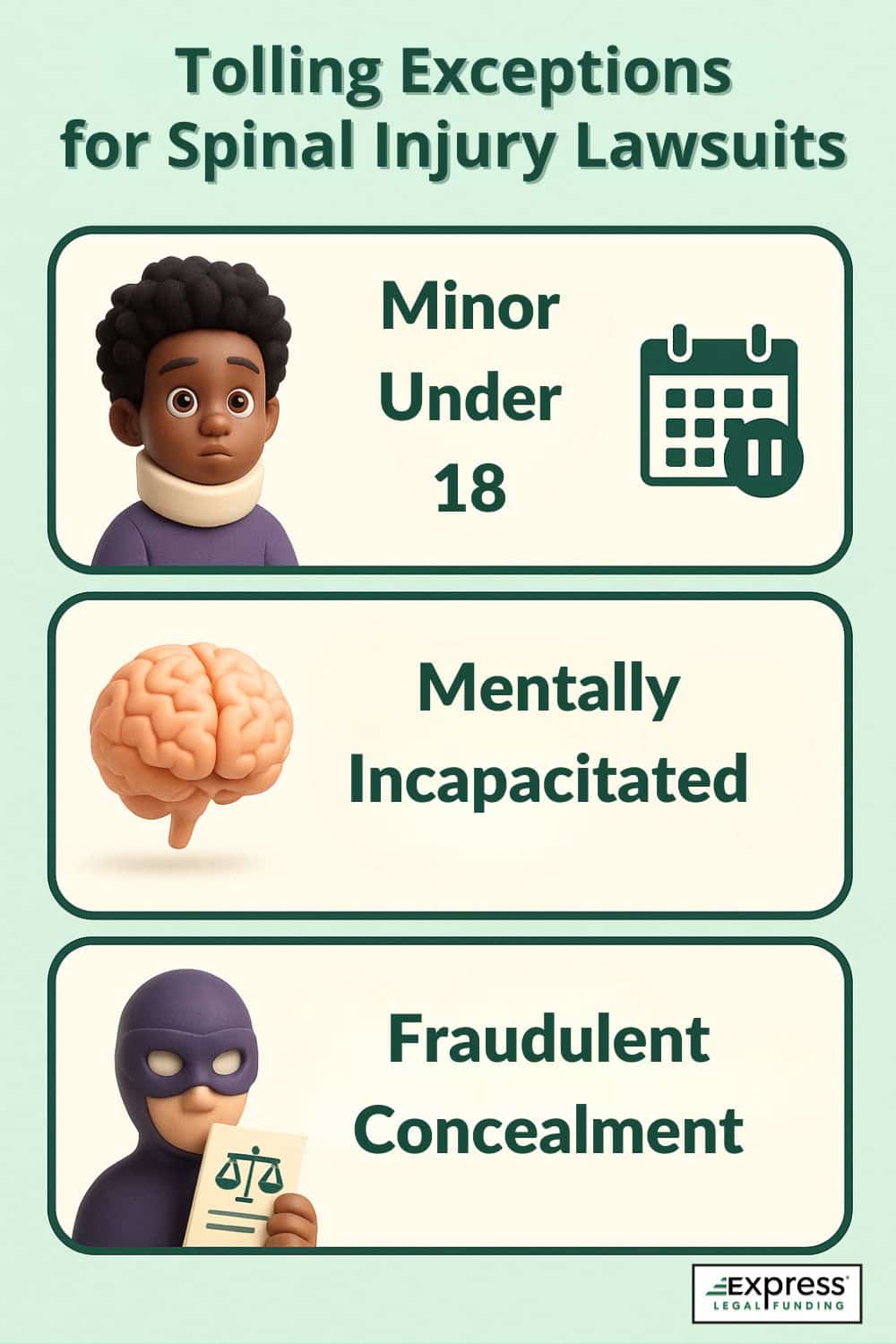
Tolling provisions are legal mechanisms that temporarily pause the statute of limitations, granting plaintiffs more time to file a lawsuit under specific circumstances. These exceptions are particularly important in spinal injury cases where delays in discovery or legal capacity can affect filing deadlines.
Common scenarios where tolling may apply:
- The injured person is a minor (under 18): The statute of limitations is often paused until the individual reaches legal adulthood.
- The victim is mentally incapacitated: If a person is deemed legally incompetent, the clock may not start until they are considered competent.
- The defendant concealed the injury (fraudulent concealment): If the defendant deliberately hides the cause or existence of the injury, tolling may apply until the fraud is discovered.
However, courts apply these exceptions stringently, and the burden of proof lies with the plaintiff to demonstrate that the tolling provisions should apply to their case. This often requires substantial evidence and legal expertise.
Therefore, it is crucial for individuals affected by spinal injuries to seek legal counsel early, ensuring that all potential avenues for tolling are thoroughly explored and that their rights are preserved within the legal timeframe.
Federal Statutes of Limitations for Spinal Injury Claims
While most spinal injury lawsuits are governed by state law, certain circumstances necessitate filing under federal jurisdiction, which introduces distinct statutes of limitations. These include:
Federal Tort Claims Act (FTCA)
Federal frameworks, such as the Federal Tort Claims Act, impose specific deadlines for claims involving federal entities, while state laws differ in their approach to personal injury and medical malpractice cases.
If your spinal injury was caused by a federal employee, say, during surgery at a Veterans Affairs (VA) hospital, you must follow FTCA procedures:
- Administrative claim deadline: 2 years from the date of injury (or discovery)
- Civil lawsuit deadline: Within 6 months of receiving a written denial of the administrative claim
- Failure to first complete the administrative step bars access to federal court.
Section 1983 Claims
Additionally, claims against government entities often require adherence to strict notice requirements, which can further complicate the process.
If a spinal injury is caused by a state actor (e.g., police excessive force, prison neglect), you may have grounds under 42 U.S. Code § 1983 for violating your constitutional rights. These are filed in federal court but follow the state’s personal injury statute of limitations.
Learn about your legal rights and filing deadlines when suing government entities in our guide to Statute of Limitations for Police Misconduct Lawsuits
Spinal Injuries on Federal Property

For spinal injuries that occur on government property (e.g., National Park accidents or the U.S. Capitol Building), FTCA rules still apply. But if the injury was due to an independent contractor or private third party operating on federal land, state law governs instead.
Statute of Limitations: Suing a Private Individual or Business vs. a Government Entity for a Spinal Injury
When pursuing legal action for spinal injuries, the distinction between suing a private party and a government entity is crucial, as it significantly influences the procedural requirements and timelines involved. We can broadly classify them as:
Private Party (Driver, Business, Doctor)
When the defendant is a private individual or entity, standard personal injury or malpractice statutes apply. The timeline begins on the date of the incident or when the injury was discovered.
Government Entity (City Bus, Public Hospital)
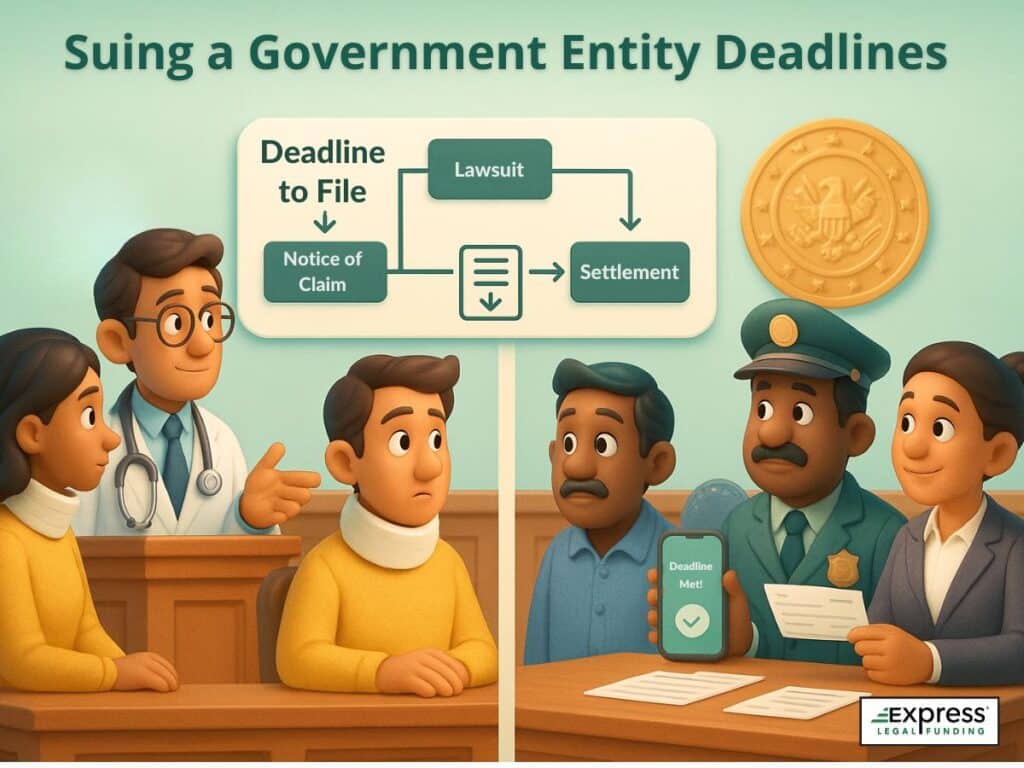
When the defendant is a government agency or employee, you often must file an administrative notice first, called a notice of claim, typically within 90 to 180 days of the injury, depending on the state. If you miss this step, the court may never allow your case to proceed.
Examples:
- California: Notice of claim within 6 months, lawsuit within another 6 months after rejection
- New York: 90 days to file a Notice of Claim; 1 year and 90 days to sue
- Georgia: 6 to 12 months for ante litem notice, depending on the level of government
Most states mandate that an administrative notice be submitted within a narrow window, often between 90 and 180 days from the date of injury. This notice serves as a prerequisite to legal action, and failure to comply with this requirement can result in the court barring the case from proceeding.
State Laws and Statute of Limitations for Filing Spinal Injury Lawsuits
The time limit for filing a spinal injury lawsuit, known as the statute of limitations, varies widely across the United States. Each state sets its own legal deadlines, which differ based on the type of injury claim and the circumstances surrounding it.
In general, the statute of limitations for spinal injury lawsuits ranges from 1 to 6 years, but the exact time frame depends on several key factors:
- The cause of the injury (e.g., auto crash vs. surgical error)
- The state’s general personal injury statute
- Special rules for medical malpractice, minors, or government defendants
For example, spinal injuries resulting from an auto crash typically fall under the state’s general personal injury statute, while those arising from surgical errors are subject to special rules governing medical malpractice deadlines.
Statute of Limitations for Spinal Injury Lawsuits by U.S. State
| State | Personal Injury | Medical Malpractice |
|---|---|---|
| Alabama | 2 years | 2 years |
| Alaska | 2 years | 2 years |
| Arizona | 2 years | 2 years |
| Arkansas | 3 years | 2 years |
| California | 2 years | 3 years from injury or 1 year from discovery |
| Colorado | 2 years | 2 years |
| Connecticut | 2 years | 2 years |
| Delaware | 2 years | 2 years (3 with discovery) |
| District of Columbia | 3 years | 3 years |
| Florida | 2 years | 2 yrs |
| Georgia | 2 years | 2 years |
| Hawaii | 2 years | 2 years |
| Idaho | 2 years | 2 years |
| Illinois | 2 years | 2 years |
| Indiana | 2 years | 2 years |
| Iowa | 2 years | 2 years |
| Kansas | 2 years | 2 years |
| Kentucky | 1 year | 1 year |
| Louisiana | 1 year | 1 year |
| Maine | 6 years | 3 years |
| Maryland | 3 years | 5 years or 3 years from discovery |
| Massachusetts | 3 years | 3 years |
| Michigan | 3 years | 2 years |
| Minnesota | 2 years | 4 years |
| Mississippi | 3 years | 2 years |
| Missouri | 5 years | 2 years |
| Montana | 3 years | 3 years |
| Nebraska | 4 years | 2 years |
| Nevada | 2 years | 3 years |
| New Hampshire | 3 years | 2 years |
| New Jersey | 2 years | 2 years |
| New Mexico | 3 years | 3 years |
| New York | 3 years | 2.5 years |
| North Carolina | 3 years | 3 years |
| North Dakota | 6 years | 2 years (6 max) |
| Ohio | 2 years | 1 year |
| Oklahoma | 2 years | 2 years |
| Oregon | 2 years | 2 years |
| Pennsylvania | 2 years | 2 years |
| Rhode Island | 3 years | 2 years |
| South Carolina | 3 years | 2 years |
| South Dakota | 3 years | 2 years |
| Tennessee | 1 year | 1 year |
| Texas | 2 years | 2 years (10-year repose) |
| Utah | 4 years | 2 years |
| Vermont | 3 years | 3 years |
| Virginia | 2 years | 2 years |
| Washington | 3 years | 3 years |
| West Virginia | 2 years | 2 years |
| Wisconsin | 3 years | 3 years |
| Wyoming | 4 years | 2 years |
Statute of Limitations for Different Types of Spinal Injury Claims
The nature of your spinal injury claim determines which statute applies. Each category also introduces complexity in proving causation, damages, and potential third-party liability. For instance, product liability cases may involve multiple defendants across jurisdictions, and tolling may apply if the defect was concealed.
Statute of Limitations for Spinal Injury Lawsuits by Cause of Injury
| Cause of Injury | Typical Legal Theory | Time Limit |
|---|---|---|
| Car or truck crash | Negligence | Typically 2–4 years, most commonly 2 years |
| Slip and fall | Premises liability | Generally 2–3 years, depending on state law |
| Botched surgery | Medical malpractice | Usually 1–3 years, often 2 years with discovery rule exceptions |
| Defective wheelchair | Product liability | Typically 2–4 years, sometimes limited by a statute of repose |
| Assault and battery | Intentional tort | Often shorter, 1–2 years, depending on the jurisdiction |
- Statute of Repose in Product Liability: In certain states, even if an injury occurs years after a product is made, you may be unable to file a claim if the product was sold more than a set period ago, typically 10–12 years from its original sale date.
- Assault vs. Negligence Timelines: Injuries from intentional acts like battery may carry shorter deadlines than unintentional accidents, a critical consideration for spinal trauma from violent incidents.
Legal Consequences of Missing the Deadline
Missing the statute of limitations deadline for filing a spinal injury lawsuit is a critical error with irreversible consequences. Courts enforce these deadlines rigorously, and failing to comply results in the dismissal of the lawsuit “with prejudice.”
What happens then?
- Lawsuit is dismissed “with prejudice.”
- You lose the right to any financial recovery
- Insurance companies no longer need to negotiate, effectively ending any possibility of compensation.
- No settlement, even if liability is clear
FAQs About the Statute of Limitations for Spinal Injuries
Can I still sue if my spinal injury symptoms started months later?
Yes, you may still be able to sue even if your spinal injury symptoms appeared months after the incident. Many states apply the “discovery rule,” which allows the statute of limitations to begin when the injury is discovered or reasonably should have been discovered, not necessarily on the date of the accident.
This rule is especially important for spinal injuries, as symptoms like nerve damage or chronic pain can take time to emerge. However, deadlines vary by state, so consult an attorney promptly to protect your rights.
What if my spinal injury happened in a VA hospital?
If your spinal injury occurred at a Veterans Affairs (VA) hospital, your claim falls under the Federal Tort Claims Act (FTCA). This law requires you to first file an administrative claim with the VA within 2 years of the injury (or when it was discovered).
If the VA denies the claim or fails to respond within 6 months, you then have 6 months to file a federal lawsuit. Failing to follow this process or missing these deadlines can permanently bar your claim.
What’s the shortest deadline to file a spinal injury lawsuit?
The shortest deadline to file a spinal injury lawsuit is typically 1 year, as seen in states like Tennessee, Kentucky, and Louisiana. Additionally, if you’re suing a government entity, you may need to file a notice of claim within as little as 30 to 90 days. Because these time limits vary by state and defendant type, it’s crucial to act quickly and consult a lawyer to avoid missing your legal window.
Get Pre-Settlement Funding on Your Spinal Injury Lawsuit with Express Legal Funding

Suffering a spinal injury can be physically, emotionally, and financially overwhelming, especially when your case is still pending in court. At Express Legal Funding, we understand how costly these injuries can be. From hospital bills and physical therapy costs to lost income and mobility aids, the expenses add up quickly.
That’s where we can help.
Express Legal Funding offers pre-settlement funding—a risk-free lawsuit cash advance provided to plaintiffs involved in personal injury lawsuits, including those suffering from serious spinal injuries. This type of funding is not a loan, which means you only repay the advance if you win or settle your case. If you lose, you owe us nothing.
We provide fast and affordable financial support to help you:
- Pay for essential living expenses while you recover
- Cover medical costs, such as surgery, rehabilitation, or mobility equipment
- Avoid insurance company pressure and stall tactics to accept a lowball settlement offer
Whether your injury involves the cervical, thoracic, lumbar, or sacral spine, we offer lawsuit cash funding tailored to the severity and strength of your case. Our team works directly with your attorney to review your claim quickly and get you cash, often in less than 24 hours of approval.
Apply for Pre-Settlement Funding Today
Don’t let financial stress worsen an already difficult situation. Contact Express Legal Funding today to find out how much cash you could receive while waiting for your spinal injury case to settle.
➡️ Apply Now or call us at (888) 232-9223 to get started.



